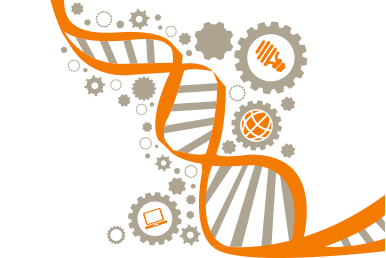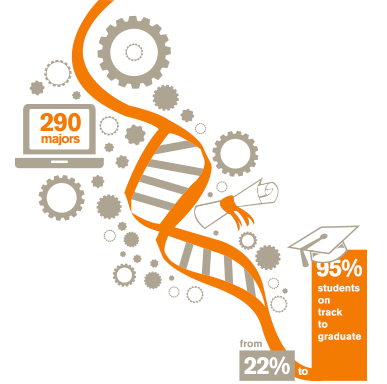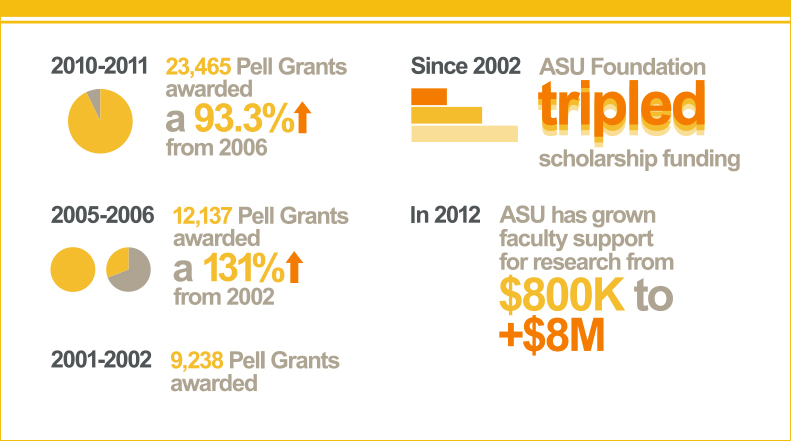Access

As one of the primary goals of the New American University, ASU is committed to the success of future and current Sun Devils. Over the past 10 years, teams at ASU created new programs, personalized learning technologies, an online learning environment and innovative transfer partnerships so that students have access to an educational experience that develops their talents and aptitudes.
interdisciplinary arts and sciences
Undergraduate students working side by side with professors on research projects – and earning stipends to do so – is almost unheard of in a university setting. But that’s happening on a daily basis through the New College of Interdisciplinary Arts and Sciences' Undergraduate Inquiry and Research Experiences program, which was inaugurated in January 2011.
Faculty members in New College’s School of Mathematical Sciences are collaborating with Glendale Community College to encourage students to pursue careers in the growing fields of biotechnology and cell/molecular biology research. New College has added a concentration in cell and molecular biology research to its existing Bachelor of Applied Science degree program. Students who have completed GCC’s Associate of Applied Science degree in biotechnology and molecular biosciences transition seamlessly into the New College program.

honors
Barrett, The Honors College serves the state of Arizona and its academically-motivated students even better by accepting a larger number of them each year and growing the overall size of the college, while maintaining the measures of honors student quality such as average SAT scores, high school GPA and class rank.
arts and sciences
The College of Liberal Arts and Sciences at ASU has offered students, faculty, teachers and public audiences access to choose, explore and sculpt a personalized and individually powerful learning experience. The proof is in the sum of the individual impacts: size does matter..
journalism
ASU’s Walter Cronkite School of Journalism and Mass Communication is closer to major metropolitan news operations – newspaper, TV, radio and online – than any journalism school in the country. Just blocks away are The Arizona Republic, the nation’s 10th largest daily newspaper; azcentral.com, the state’s leading news website; KPNX-TV/Channel 12, the region’s NBC affiliate; Fox10/KSAZ-TV; Fox Sports Net; CBS Radio; the Phoenix Business Journal and La Voz, a leading Spanish language newspaper. Other daily news operations are within a few miles. Also close by are major public institutions such as Phoenix City Hall, federal, state and local courthouses and government agencies as well as major sports, cultural and entertainment attractions all of which provide students with rich reporting opportunities.
public programs
The School of Social Work, in the College of Public Programs, has one of the three highest numbers of American Indian social work students in the United States.
As the only graduate social work program in Arizona, the school is a leading trainer for personnel in Arizona social service agencies, especially in behavioral health and child welfare.
The School of Public Affairs, also in the College of Public Programs, offers the only program in the region accredited by the National Association of Schools of Public Affairs and Administration, uniquely positioning the school to respond to new demands on public leadership in the context of the unprecedented and complex issues of global urban governance.

eAdvisor
The university has ramped up efforts to increase freshmen retention and accommodate the distinctive learning needs of its students. These efforts include an online student advising system, called eAdvisor, developed by ASU Provost Elizabeth Phillips in 1996 when she was at the University of Florida, where it resulted in a 20 percent increase in the graduation rate. It charts out and monitors progress of complete degree plans for students based on their academic major.
eAdvisor allows students to search potential majors by entering general terms such as “I like working with people,” “I am good with computers” or “I want to put my art talent to use.” While students still meet with human advisors, the online system produces a list of appropriate majors and maps out the courses needed to complete each degree. The critical courses diagnostic of success in a major are added early in the sequence, so students can discover earlier if they are in a major not suited for them.
“eAdvisor is premised on the idea that students can succeed if they are in the right major,” Phillips said. “ASU has 290 majors, which can be bewildering to administrators as well as students. The system also ensures students are taking the correct classes in the correct order to obtain their degree on time. When we started eAdvisor, only 22 percent of our students were on the correct course path for their majors. Now 95 percent are.”
libraries
ASU Libraries has adopted the electronic platform for books and journals as the preferred format. Currently, about 80 percent of the collections budget is devoted to electronic materials, which ensures ubiquitous access for ASU researchers regardless of their location. The ASU community now has access to more than 364,000 electronic books and almost 36,000 electronic journal titles.
letters and sciences
In 2009, the School of Letters and Sciences pioneered a doctorate program in behavioral health – the first of its kind in the nation and the first doctorate now offered through ASU Online. It delivers an innovative, results-oriented curriculum aimed at meeting the demands of health care reform and evidence-based patient solutions.
business
The W. P. Carey School of Business launched an online MBA program, making it one of the first highly regarded universities to enter the field. The program now ranks among the top 14 online MBA programs in the nation, according to U.S. News & World Report.
The school achieves an impressive mix of ASU’s access and excellence values. Even while the school continues to climb in academic rankings, it has surpassed the 10,000-student mark. The undergraduate population, in particular, increased more than 20 percent during the decade. At the same time, the average standardized test scores for incoming freshmen rose.
disability resources
In 2001, ASU’s Disability Resource Center served 1,100 students. To accommodate growth and student needs, the center increased capacity for all programming. Now in 2012, the center is serving 2,731 students.
The center is committed to keeping all assistive technology current to best meet student needs. The equipment in the computer lab, including all new assistive technology hardware and software, has been updated.
The Kurzweil 3000, a software package specific to students with learning disabilities such as attention deficit hyperactivity disorder and other disabilities related to reading difficulties, is now available on ASU’s cloud platform for students to use anywhere, anytime. This enables students to access electronic textbooks from home, class or in the lab via the Internet.

diversity
One of the university’s greatest commitments is to ensuring that all students have access to higher education regardless of income. Students with the greatest financial need may be awarded Federal Pell Grants. During the 2010-11 academic year, 23,465 students were awarded Pell Grants. This is a 93.3 percent increase from the 2005-06 academic year in which 12,137 students received Pell Grants. Overall, ASU has seen a significant increase in grant recipients, a staggering 154 percent rise since the 2001-02 academic year when 9,238 grants were awarded.
The 9/11 GI Bill has allowed for veterans and their dependents to receive an education with support from the government. To assist these students with the transition from the military to a university setting, ASU opened the Pat Tillman Veteran Center in 2009. Vets may also take advantage of programs such as Veterans Upward Bound and a Veteran Student Success course.
foundation
The goal of the ASU Foundation for a New American University is to ensure the success of ASU. A critical part of that is making sure that the foundation supports students by providing scholarships and other financial assistance to make a great education at ASU a reality. Since 2002, the ASU Foundation has tripled scholarship funding and grown faculty support for research from $800K to more than $8 million in 2012.
The foundation also provides student support programs through the ASU Parents Association, which provides everything from free tutoring to a Thanksgiving dinner for students who can’t make it home for the holidays.